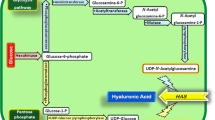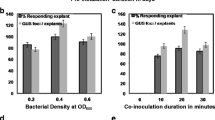Abstract
Nowadays, transgenic plants are considered as an expression system for therapeutic recombinant proteins. One of the approaches to recombinant protein production is the introduction of the relevant genes to plant cells and produce hairy roots from these cells using the plant tissue culture methods. L-asparaginase II is one of the important therapeutic enzymes used in the treatment of cancer, especially in the treatment of acute lymphoblastic leukemia (ALL) in children. In this study, L-asparaginase II (ansB) gene was isolated from Escherichia coli YG001 and overexpressed in Solanum tuberosum. The sequence of L-asparaginase II gene was optimized according to the codon usage table of S. tuberosum and cloned into the plant expression vector pBI121. Protein, DNA, and RNA of transgenic hairy roots were investigated. It was demonstrated that the ansB gene was correctly integrated into the genomic DNA of transgenic plants. The whole protein of transgenic roots was used for the assay of L-asparaginase II activity, the higher activity of L-asparaginase II was observed in transgenic hairy roots when compared with non-transgenic ones, and the recombinant protein was detected using western blot.
Similar content being viewed by others
References
Avramis VI, Panosyan EH. 2005. Pharmacokinetic/pharmacodynamic relationships of asparaginase formulations. Clin. Pharmacokinet. 44: 367–393
Bensaddek L, Villarreal ML, Fliniaux MA. 2008. Induction and growth of hairy roots for the production of medicinal compounds. Electron. J. Integr. Biosci. 3: 2–9
Borek D, Jaskólski M. 2001. Sequence analysis of enzymes with asparaginase activity. Acta Biochim. Polonica-English Ed. 48: 893–902
Bradford MM. 1976. A rapid and sensitive method for the quantitation of microgram quantities of protein utilizing the principle of protein-dye binding. Anal. Biochem. 72: 248–254
Broome J. 1961. Evidence that the L-asparaginase activity of guinea pig serum is responsible for its antilymphoma effects. Nature 191: 1114–1115
Cassileth PA, Harrington DP, Appelbaum FR, Lazarus HM, Rowe JM, Paietta E, Willman C, Hurd DD, Bennett JM, Blume KG. 1998. Chemotherapy compared with autologous or allogeneic bone marrow transplantation in the management of acute myeloid leukemia in first remission. N. Engl. J. Med. 339: 1649–1656
Chen PY, Wang CK, Soong SC, To KY. 2003. Complete sequence of the binary vector pBI121 and its application in cloning T-DNA insertion from transgenic plants. Mol. Breed. 11: 287–293
Collins GB, Shepherd RJ. 1996. Engineering plants for commercial products and applications. Ann. NY Acad. Sci. (USA)
Dhanam Jayam G, Kannan S. 2013. L-asparaginase-Types, Perspectives and Applications. Adv. Bio. Tech. 13: 01–05
Doran PM. 2000. Foreign protein production in plant tissue cultures. Curr. Opin. Biotechnol. 11: 199–204
Ebrahiminezhad A, Rasoul-Amini S, Ghasemi Y. 2011. l-Asparaginase production by moderate halophilic bacteria isolated from Maharloo Salt Lake. Ind. J. Microbiol. 51: 307–311
Farzaneh A, Adel Y, Ali N, Younes G. 2013. Determine Effective Concentrations of β-lactam Antibiotics Against three Strains of Agrobacterium Tumefaciens and Phytotoxicity on Tomato and Tobacco. Int. J. Agron. Plant Prod. 4: 2919–2925
Fischer R, Emans N. 2000. Molecular farming of pharmaceutical proteins. Transgen. Res. 9: 279–299
Fischer R, Stoger E, Schillberg S, Christou P, Twyman RM. 2004. Plant-based production of biopharmaceuticals. Curr. Opin. Plant Biol. 7: 152–158
Halford NG, Muttucumaru N, Curtis TY, Parry MA. 2007. Genetic and agronomic approaches to decreasing acrylamide precursors in crop plants. Food Addit. Contam. 24: 26–36
Hockney RC. 1994. Recent developments in heterologous protein production in Escherichia coli. Trends Biotechnol. 12: 456–463
Hu ZB, Du M. 2006. Hairy root and its application in plant genetic engineering. J. Integr. Plant Biol. 48: 121–127
Jha SK, Pasrija D, Sinha RK, Singh HR, Nigam VK, Vidyarthi AS. 2012. Microbial L-Asparaginase: a review on current scenario and future prospects. Int. J. Pharma Sci. Res. 3: 3076–90
Kidd JG. 1953. Regression of transplanted lymphomas induced in vivo by means of normal Guinea pig serum II. Studies on the nature of the active serum constituent: Histological mechanism of the regression: Tests for effects of guinea pig serum on lymphoma cells in vitro: Discussion. J. Exp. Med. 98: 583–606
Kiriyama Y, Kubota M, Takimoto T, Kitoh T, Tanizawa A, Akiyama Y, Mikawa H. 1989. Biochemical characterization of U937 cells resistant to L-asparaginase: the role of asparagine synthetase. Leukemia 3: 294–297
Kozak M. 1989. The scanning model for translation: an update. J. Cell Biol. 108: 229–241
Krishnapura PR, Belur PD, Subramanya S. 2015. A critical review on properties and applications of microbial l-asparaginases. Crit. Rev. Microbiol. 1–18
Kumar DS, Sobha K. 2012. L-Asparaginase from Microbes: a Comprehensive Review. Adv. Biores. 3: 137–157
Laemmli UK. 1970. Cleavage of structural proteins during the assembly of the head of bacteriophage T4. Nature 227: 680–685
Lu HS, Hsu YR, Lu LI, Ruff D, Lyons D, Lin FK. 1996. Isolation and characterization of human tissue kallikrein produced in Escherichia coli: Biochemical comparison to the enzymatically inactive prokallikrein and methionyl kallikrein. Protein expression and purification. Protein Expr. Purif. 8: 215–226
Ma JKC, Barros E, Bock R, Christou P, Dale PJ, Dix PJ, Fischer R, Irwin J, Mahoney R, Pezzotti M. 2005. Molecular farming for new drugs and vaccines. EMBO Rep. 6: 593–599
Miao Y, Ding Y, Sun QY, Xu ZF, Jiang L. 2008. Plant bioreactors for pharmaceuticals. Biotechnol. Genet. Engin. Rev. 25: 363–380
Michalska K, Jaskolski M. 2006. Structural aspects of L-asparaginases, their friends and relations. Acta Biochim. Polonica-English Ed. 53: 627–640
Moola ZB, Scawen M, Atkinson T, Nicholls D. 1994. Erwinia chrysanthemi L-asparaginase: epitope mapping and production of antigenically modified enzymes. Biochem J. 302: 921–927
Odell JT, Nagy F, Chua NH. 1985. Identification of DNA sequences required for activity of the cauliflower mosaic virus 35S promoter. Nature 313: 810–812
Oettgen H, Old L, Boyse E, Campbell H, Philips F, Clarkson B, Tallal L, Leeper R, Schwartz M, Kim JH. 1967. Inhibition of leukemias in man by L-asparaginase. Cancer Res. 27: 2619
Oza VP, Parmar PP, Patel DH, Subramanian R. 2011. Cloning, expression and characterization of l-asparaginase from Withania somnifera L. for large scale production. 3 Biotech. 1: 21–26
Oza VP, Trivedi SD, Parmar PP, Subramanian R. 2009. Withania somnifera (Ashwagandha): a novel source of L-asparaginase. J. Integr. Plant Biol. 51: 201–206
Richards NG, Kilberg MS. 2006. Asparagine synthetase chemotherapy. Ann. Review Biochem. 75: 629–654
Rommens CM, Yan H, Swords K, Richael C, Ye J. 2008. Lowacrylamide French fries and potato chips. Plant Biotechnol. J. 6(8): 843–53
Sambrook, J., Fritsch, E. F., & Maniatis, T. 1989. Molecular cloning: a laboratory manual (No. Ed. 2). Cold spring harbor laboratory press.
Schouten A, Roosien J, van Engelen FA, de Jong GI, Borst-Vrenssen AT, Zilverentant JF, Bosch D, Stiekema WJ, Gommers FJ, Schots A. 1996. The C-terminal KDEL sequence increases the expression level of a single-chain antibody designed to be targeted to both the cytosol and the secretory pathway in transgenic tobacco. Plant Mol. Biol. 30: 781–793
Sedmak JJ, Grossberg SE. 1977. A rapid, sensitive, and versatile assay for protein using Coomassie brilliant blue G250. Anal. Biochem. 79: 544–552
Siddalingeshwara K, Lingappa K. 2010. Screening and optimization of L-asparaginase-A tumour inhibitor from Aspergillus terreus through solid state fermentation. J. Adv. Sci. Res. 1: 55–60
Stewart Jr CN, Via LE. 1993. A rapid CTAB DNA isolation technique useful for RAPD fingerprinting and other PCR applications. Biotechniques 14: 748–750
Stöger E, Vaquero C, Torres E, Sack M, Nicholson L, Drossard J, Williams S, Keen D, Perrin Y, Christou P. 2000. Cereal crops as viable production and storage systems for pharmaceutical scFv antibodies. Plant Mol. Biol. 42: 583–590
Thirumurugan G. 2011. Effect of inducers and physical parameters on the production Of L-Asparaginase using Aspergillus Terreus. J. Bioproc. Biotech. 1: 2–8
Tiwari S, Verma PC, Singh PK, Tuli R. 2009. Plants as bioreactors for the production of vaccine antigens. Biotechnol. Adv. 27: 449–467
Vaucheret H, Fagard M. 2001. Transcriptional gene silencing in plants: targets, inducers and regulators. Trends Genet. 17: 29–35
Weisshaar R. 2004. Acrylamide in bakery products-Results from model experiments. Deutsche Lebensmittel-Rundschau. 100: 92
Xu J, Dolan MC, Medrano G, Cramer CL, Weathers PJ. 2012. Green factory: plants as bioproduction platforms for recombinant proteins. Biotechnol. Adv. 30: 1171–1184
Yarizade A, Aram F, Niazi A, Ghasemi Y. 2012. Evaluation of effect of β-Lactam antibiotics on suppression of different strains of Agrobacterium tumefaciens and on wheat mature embryo culture. Iran. J. Pharm. Sci. 8: 267–276
Youssef MM, Al-Omair M. 2008. Cloning, purification, characterization and immobilization of L-asparaginase II from E. coli W3110. Asian J. Biochem. 3: 337–350
Author information
Authors and Affiliations
Corresponding author
Additional information
Competing interests
The authors declare that they have no competing interests.
Rights and permissions
About this article
Cite this article
Mohammadi, A., Niazi, A., Aram, F. et al. Transformation of the L-Asparaginase II Gene to Potato Hairy Roots for Production of Recombinant Protein. J. Crop Sci. Biotechnol. 23, 81–88 (2020). https://doi.org/10.1007/s12892-018-0030-0
Received:
Revised:
Accepted:
Published:
Issue Date:
DOI: https://doi.org/10.1007/s12892-018-0030-0




